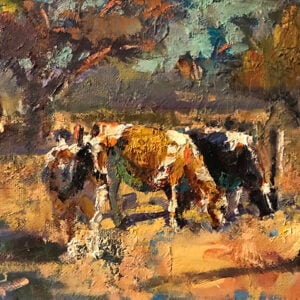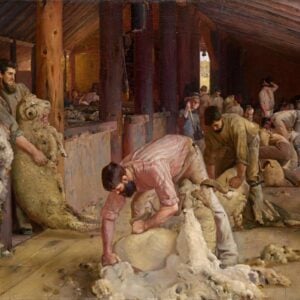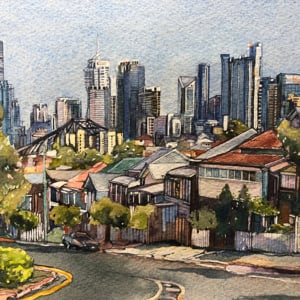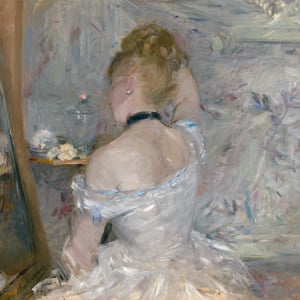In my last post, I took you on a virtual journey of the European Masterpieces exhibition that took place here in Brisbane, Australia. Someone commented that each painting is so beautiful it warrants individual study. I agree. So over the next few weeks, I’m going to be taking a closer look at a handful of my favorites from the exhibition.
The first: Gardanne by Paul Cézanne.
This was a quiet painting in a noisy room, but something about it caught my attention. I found it to be a joy to look at in person. I couldn’t explain why at the time, other than it simply worked. Great art doesn’t need any more justification than that, but for the purpose of our studies, let’s dive a bit deeper.
I’ll cover:
- Unfinished Appearance
- Composition
- Color Theme
- Value (Grayscale and Notan)
- Great Art Gets Better With Time
- Frame
- Similar Paintings
- Key Takeaways
- Additional Resources
- Want to Learn More?
- Thanks for Reading!

(Click here to see a high-resolution photo of the painting.)
Unfinished Appearance
The first thing you might notice about the painting is its unfinished appearance. There are several areas where the bare canvas is exposed. You can even see parts of Cézanne’s initial sketch (refer to the below closeup).
I did some searching as to whether this was by design or if Cézanne simply didn’t get around to making the finishing touches. I was unable to find anything conclusive either way, but I assume it was by design. Many of Cézanne’s paintings have a similar unfinished appearance. Plus it seems to work well with Cézanne’s brash style and the idea of weathered architecture.

Composition
The painting has a strong geometric theme, as you might expect from Cézanne. There are many overlapping buildings, windows, poles, walls, etc. Even the trees and patches of land form rough geometric shapes.
Notice how the verticle dimensions of the painting mimic the tall buildings, particularly the tallest one. Towards the end of this post, you’ll see a horizontal version of this painting. I don’t think it works as well.
There’s no strong focal point. Rather, the painting as a whole is in focus. This is typical of Impressionism. Cézanne was likely more interested in the unique arrangement of shapes and colors than the city itself.
The buildings are arranged in a rough zig-zag that helps lead our eyes through the painting. See below. It ends at the peak of the tallest building. The building at the bottom, whilst unfinished, plays an important role in starting the zig-zag motion.

Color Theme
In terms of the overall color theme, the main colors are orange, green, blue, and the warm-tinted color of the bare canvas. Notice how all the colors are distinct, with there being hardly any gradation or blending. This gives the painting a sharp hue contrast.
There’s hardly any saturation contrast. Most of the colors are restrained (there aren’t any vivid reds, yellows, or blues). This contributes to the painting’s pleasant, understated feel.
The warm-tinted color of the bare canvas gives the painting an overall warm presence. You can almost feel the warmth of the sunlight basking over the city and bouncing off the roofs.

(You can use this tool by Adobe to extract the color theme of a painting.)
Value (Grayscale and Notan)
Below is a grayscale of the painting, revealing how light or dark all the colors are.

Most of the colors gravitate around the middle of the value scale. There aren’t any deep shadows or brilliant highlights. It’s an understated painting in this sense. But the lack of value contrast meant Cézanne was able to inject more color into the painting. Instead of black and brown shadows, he used pale blues and greens. This might not be as striking to the eye, but it is pleasant.
I also created a notan of the painting using Photoshop. See below. This is the most basic design of lights and darks. It can often reveal interesting patterns and clues about why the painting works (or doesn’t). A strong notan design typically conveys a sense of realism despite the lack of color and detail.
In this case, the painting has a rather scattered and weak notan design. That is not a criticism of the painting itself. It merely suggests that Cézanne relied more so on saturation and hue than value to convey realism.

Great Art Gets Better With Time
The painting is starting to show its age, with many visible cracks. This seems to add to the idea of a weathered, aging city.
I remember hearing once that great architecture gets better with time. The same can be said for great art.

Frame
Of course, credit also needs to go to the beautiful frame. It complements the paintings without competing for attention, as is the purpose of a great frame. The dark colors also help accentuate the lightness of the painting. Remember, painting is all about contrast. To push the lights, surround them with darks.

Similar Paintings
Below are two similar paintings featuring Gardanne. The first is a horizontal view with richer colors and a more complete finish. The inclusion of a grassy foreground also gives it a more spacious feel.

The second is a verticle composition from a different perspective. Notice how we can see the tallest tower and two buildings on the hill in the background in all three paintings. You can use these objects as common reference points to determine where Cézanne painted from.

Key Takeaways
- Photos are great, but nothing compares to seeing paintings in person.
- You don’t need to bring every painting to a clean, refined finish. Sometimes it might be more effective to leave parts slightly unfinished, as Cézanne did.
- Can you paint the subject in a way that leads the viewer through the painting? In this case, the buildings form a rough zig-zag motion that leads you to the peak of the tallest building.
- Painting with a restrained color palette and within a compressed value range can give your painting a pleasant, understated appearance.
- Great art gets better with time.
- The frame plays an important role in providing a point of contrast and containing our attention on the painting.
Additional Resources
European Masterpieces – Monet, van Gogh, Rubens, Velázquez, and More
A Closer Look at the Mont Sainte-Victoire Series by Paul Cézanne
Want to Learn More?
You might be interested in my Painting Academy course. I’ll walk you through the time-tested fundamentals of painting. It’s perfect for absolute beginner to intermediate painters.
Thanks for Reading!
I appreciate you taking the time to read this post and I hope you found it helpful. Feel free to share it with friends.
Happy painting!
Dan Scott

Draw Paint Academy







Thank you for being kind and to take the time to explain certain details. Artist sometimes paint without purposely doing some technique. The technique can be analyzed but not necessarily be determined to be purposeful.
Hello from Perth Western Australia.
Thank you, Dan, for your hard work. I love this Cezanne – just marvelous.
I am not an artist: I am hoping to attend classes as soon as possible and you are keeping me focused on that goal.
Thanks again!!! – Colleen
Thank you for this detailed insight into cezannes paintings. Although I have enjoyed seeing his paintings in the past I never appreciated how he presented them. It’s given me much to think about for the future.
Another great review,allways interesting and informative. Thanks Dan
Thank you so much Dan for your generosity of thoughts and time. I love getting your emails, always interesting and informative.
This has been a lovely read, such an interesting post, so many new aspects for me. Thank you!
Hello from Boston!
Your explanation was so insightful. I’m wondering if Cezanne left his works with that “unfinished look” as a result of painting en Plein air and with the thought of finishing them in studio, but then deciding they were right just the way they were! You can definitely see his use of transparency in his oils. Leaving parts of the canvas unpainted might be influenced by his wonderful watercolors, where you let the paper shine through to help tell part of the story?
Very interesting to have this painting analysed like this. Im particularly struck by how it has a narrow value range and no blending. He gained perspective more by composition than by defined foreground and blurry background. And yet it works so well. Thank you for your observations. I’m in Canada and a painter by hobby.
Your analysis is very helpful not only in appreciating Cezanne’s art, but keeping it in mind for my own future paintings. Thank you!
P.S. I’m fortunate to live in the Washington area, where the National Gallery is part of Smithsonian. All their museums are free.
Thanks Dan – I really enjoy your detailed and accessible explanations of paintings. I don’t paint but they really increase my enjoyment of a picture.
Thank you for this thoughtful commentary, Dan. Your use of digital tools is very interesting and much appreciated as I know little about what is available out there to support my art.
Thanks for helping me understand all the aspects of this painting. I’m from a rural farming community in Ohio.
Wonderful explanations Dan , thank you , much appreciated.
Thanks Dan for sharing all your knowledge and explanations of why each masters painting works yet still breaks painting “rules “,; whether the artist intended it to do so or not we may not know. You invest a lot of your time making us better artists even if like me we work mainly for ourselves and not to sell.
Thank you so much for this valuable insight in Cezanne’s Gardanne! It is so helpful that you pointed out his use of color, the zigzag, the unfinished portion and the pleasant calmness of the overall painting! Thank you so much! Love this painting!
Very interesting and helpful interpretation of his painting.
I enjoy your teachings so much! I paint with oils and watercolors. Sometimes my drawing is need I get help. I trace a lot or don’t sketch at all. Thanks for your posts
I enjoy your teachings so much! I paint with oils and watercolors. Sometimes my drawing is need I get help. I trace a lot or don’t sketch at all. Thanks
Hi from Curacao, Dutch West Indies. Thank you for this inspiring overview. Being a part of an urban sketcher group it gives insight on how to develop my own sketches.
Thank you for taking the time to educate me on art. I really enjoy the information you share.
Thank you so much. Helps me understand all the intricacies and dynamics of art.
How interesting this artist is.. who would have ever thought an “unfinished painting” could look so amazing! Thank you Dan, once again , a very interesting study from you..
Thank you again, Dan. Always greatly enjoy your insights into these works of art. I learn every from every single post.
Valuable information, knowledge, to share fine detail ,regarding painting ,which is unseen by me,thanks again
Thank Dan…..
Big thanks. Cezanne is my sweetheart.
Vlado
Thank you for sharing your critique of this wonderful painting. Much appreciated.
Every so often I get the urge to get out my paints and give it another try. I’m 81 years old and get discouraged easily, but your lessons might actually get me to follow through. Thank you.
Do start paintIng. I am 82 and get so much from making the effort. It keeps the grey cells working and let’s you see the world again with joy. Give it a go. Nick
Thanks Dan for this thoughtful and valable insight in Cezanne’s Paint.
This is part of another great chapter of your lessons.
Thank you, Dan. It’s been years since I studied fine art, and find it amazing so much more is known now about respected artists. I understand Cezanne painted slowly and deliberately, unlike his impressionist friends who applied paint quickly, covering the ground and ‘capturing the moment’. Here his high-key painting, portraying sunlight on the city walls, compared to other studies, one in deeper richer colours (more notan), and the other again definitely ‘unfinished’. I often wonder if he just liked them that way, or perhaps didn’t get round to finishing them. He was under no pressure to do so. It’s lovely to be able to compare them, to see the frame and its effect. It almost makes up for not being able to attend the exhibition personally. I look forward to your next commentary.
Thanks so much, Dan. I cannot properly tell you how much your breakdown solved long standing issues that I’ve had in my paintings over time. Also, it gives me many different aspects to view a commission I’ve been working on lately that will be invaluable in moving forward. Wonderful!
Horizontal view is better.
Thank you for the analysis, Dan. I like Cezanne’s work, the way he paints a little town or village, uses the right colours, leads the eye through the work, and brings it all together to a finished masterpiece. It looks simple but it is not easy. I have tried it a couple of times, once on a country town and once on some city houses. Both did not work. The village came close but the city one was too difficult. And the modern architecture was not to blame; the problem was my lack of skill.
Thank you for your studied education in all areas of art… I particularly loved your reference to the frame and how it contributes or not to a painting… I have been much more interested in what the framing does for a painting more recently and you are absolutely correct. Wish there was an economic method to obtain reasonably priced fabulous framing…. always look forward to your posts!!
Dan, I am so pleased you mentioned the frame. We usually see photos of just the painting, but a frame can set a piece up, or add nothing to it.
WoW, I am learning so much. So often as a beginner I am intimidated to even ask the question. I went all through my education with never having any courses I. The Arts, ever, all sciences. Now in my retirement I am desperately trying to rectify this huge gap! Your evaluations and descriptions are really helping me so much. I have a long way to go but will not be so intimidated to ask questions? Thank you so much to help me open this mew world!
I don’t practice oil painting (I am more of pencil, pen & ink, and watercolor type), but I have been teaching art appreciation and how to look at art for 40 years or so, and frankly, your classes are amazing! The depth and clarity are quite a feast for the eyes and the intellect. Thank you!!
I’m learning. Certain aspects of. Different Artists. Thanks Dan mate. Your posts are. Unbelievable a awsome. Teacher. 😎